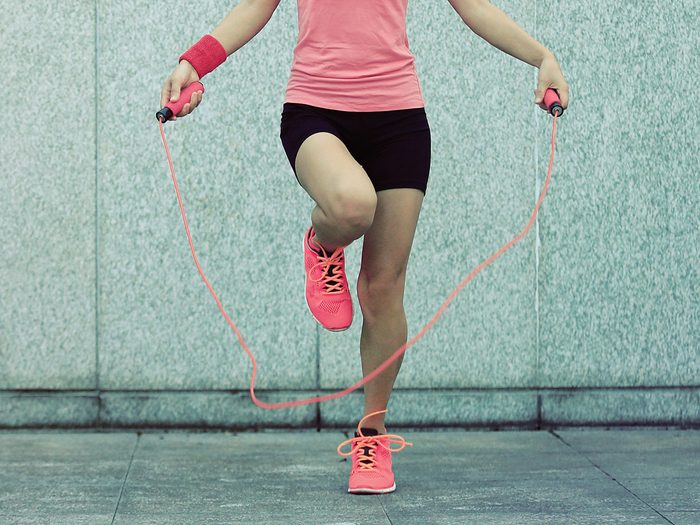Here’s Why You May Want to Start Skipping Rope Again

It’s good cardio and engages practically all of your muscles.
Forget walking and chewing gum at the same time: At one point, ages ago, many of us could actually skip rope while we sang. In fact, somewhere, jammed into a closet or the corner of a basement, there’s probably a dusty old jump rope that would just love if you gave it another look. You might be surprised at how hard a workout you’ll get—and how quickly the words to “Miss Mary Mack” come flooding back (back, back).
Bit of skipping rope = big rewards
Like any exercise that involves short, quick, explosive movement, skipping is a plyometric workout, which offers plenty of high-intensity bang for its buck. Yes, that means more speed and power: A 2021 meta-analysis found that endurance runners improved their physical fitness and athletic performance after introducing jump training into their routines. But plyometric exercise also has a lot to offer anyone whose marathon days might be behind them. One 2018 Sports Medicine review determined that plyometric activity improved postural stability in older adults, leading to a reduced risk of falling. A 2020 European study found that plyometric exercise helped older men better climb stairs, especially when stacked against walking or resistance training. And a Cincinnati meta-analysis of female athletes connected plyometric exercise with a reduced risk for ligament injury, because of its ability to improve coordination.
And you don’t need to do a ton of it: An oft-cited study in Research Quarterly for Exercise and Sport revealed that skipping for 10 minutes a day over six weeks can provide the same benefits as half an hour of daily jogging. But, because skipping isn’t nearly as easy as nine-year-olds make it seem, work up to those 10 minutes. “You are definitely getting your heart rate up—the most I can last without stopping is somewhere between three to four minutes,” says Scott Lear, who holds the Pfizer/Heart and Stroke Foundation chair in cardiovascular prevention research at Vancouver’s St. Paul’s Hospital (and is an avid skipper himself). “But that’s how you get a similar workout to a moderate-intensity activity in less time.”
(Related: 6 Great Spin Bikes that Cost Less Than a Peloton)
Heart health benefits of skipping
Your calves, quads, hamstrings, biceps, shoulders, arms, core—they’re all pressed into service here. But skipping is also one of the most effective cardio workouts around. “Skipping makes your cardiovascular system more efficient at delivering and extracting oxygen from your blood,” Lear says. “So the heart doesn’t have to pump as much at a certain work level, and it can better manage the sort of stress that precipitates a heart attack.” A 12-week 2018 European study found that skipping positively affected several risk factors associated with cardiovascular disease, including blood pressure, inflammation and vascular function.
Bone heatlh benefits of skipping
Two million Canadians are affected by osteoporosis—more than 80 percent of them women. We know that regular exercise is good for bone health for young girls all the way through older women, but it turns out that skipping rope is really good for our bone health. By putting bones under the repeated stress of jumping, you encourage them to build back stronger. That’s why (American) study after (Chinese) study after (Australian) study has found that skipping rope increases bone mineral density in both pre- and post-menopausal women, even those with low bone mass.
Plus, skipping rope is just generally good for what’s known as our physical literacy: moving with confidence and competence. “A lot of the time, we talk about physical literacy in children, improving balance and coordination,” Lear says. “But that’s also important as we get older, because it’s not only age that reduces those things, it’s usually that we start doing less.” As we do less, our bodies adapt to doing less; they’re efficient machines that way. Skipping helps ensure our bodies stay healthy, no matter our age—so hop to it.
Check Your Technique
Kaitlyn Simpson, performing circus artist and coach at the Jumpsations jump-rope club in Hamilton, Ont., shares three tips for improving your jump rope technique.
1. For novices, keeping your toes and your heels together as you jump—and landing with a bent knee—will make sure your joints and ligaments don’t end up where they shouldn’t. Hips face forward, right under your shoulders, and hands are as close to those hips as possible, with elbows tucked back.
2. Beginners tend to think they need to turn the rope with their whole arms, but after you get those initial revolutions going, the work is all in the wrists. Shortening your rope a little will encourage you to keep your arms closer to your body, so the rotation can come from your wrists instead.
3. If you’re working on your coordination, go ahead and jump a little higher: It’ll give you more time to get the rope under you before you land. But once you figure out your rhythm, you shouldn’t need to get more than an inch or two off the ground.
Next: Can the Rookie Smart Rope Help You Get a Good Workout?




